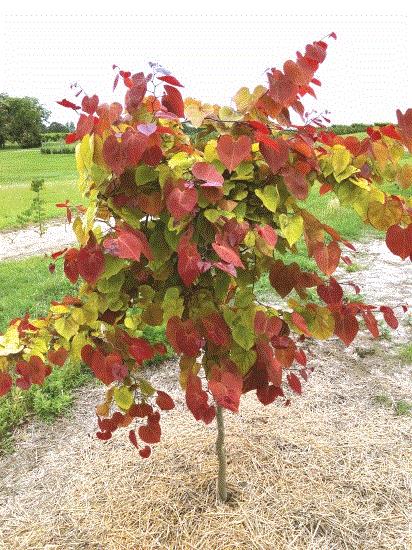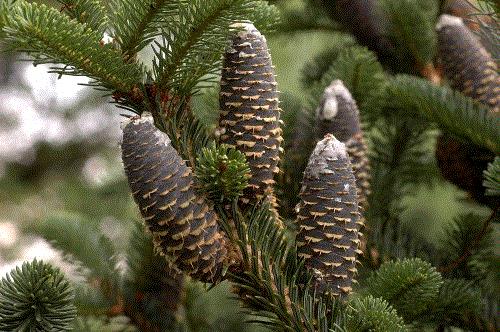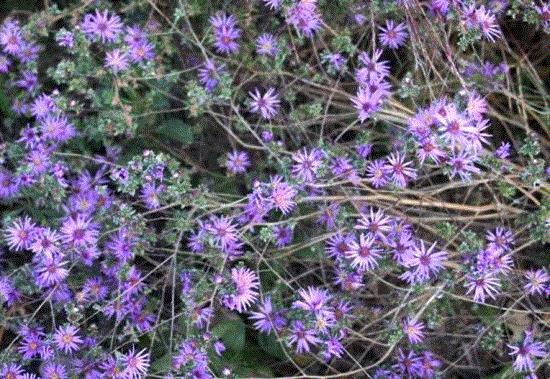Flame Thrower Redbud Rocks the UK
How about ole’ Dr. Denny Werner and Star Roses & Plants taking home top honors at the Chelsea Flower Show. Specifically, Flame Thrower Cercis has won Plant of the Year 2021 at the Royal Horticultural Society (RHS) Chelsea Flower Show.
“The Chelsea Flower Show is one of the world’s most prestigious horticultural events and we’re thrilled that Flame Thrower was recognized as the most exciting, innovative and diverse new plant of 2021,” says Bradd Yoder, President at Star Roses and Plants.

Fun fact: This cultivar is sold as Eternal Flame in the United Kingdom and Europe.
As I've covered in a previous newsletter, Flame Thrower is a very impressive redbud that turns heads with its bold foliage colors. Its stunning color display is persistent throughout the season, often showing hues of reds, oranges, yellows and greens all on a single branch. The intensity of colors changes throughout the seasons with reds and oranges more prominent in spring, followed by yellows and greens in summer.
The eye-catching display is a color breakthrough for the Cercis category. Not only will the foliage give you color throughout the season, but clusters of pink blooms are also produced in early spring for added garden appeal. This tree will grow to about 15 to 20 ft. and will perform best in Zones 5 to 9.

Webinar: The Sustainability of Peat
Date: Wednesday, October 27, 2021
Time: 1:00 p.m. Eastern/12:00 p.m. Central
As consumers and suppliers become more climate-conscious, there have been questions about the long-term viability and sustainability of the harvesting and use of sphagnum peat moss, which has long been an important component of soilless media because of its fibrous structure, water-holding capacity and low nutrient content. Because it’s a natural product, growers often ask about how peat is harvested and processed, and about its availability, both short-term and long-term.
In this webinar, Susan Parent of Premier Tech Horticulture will explain all the details of today’s sphagnum peat moss industry, including how harvest sites are restored, and the sustainability and outlook of this valuable resource for future generations of growers and gardeners.

With more than 35 years at Premier Tech, Susan has been part of the Innovation Team, developing active ingredients for horticultural plants. She has a deep knowledge of microbiology, and for the last 10 years has been part of Premier Tech's Grower Services team, supporting greenhouse growers and working with them to improve the quality of their crops. Susan has many years of knowledge and experience in the peat moss industry in Canada, including sphagnum peat moss harvesting, processing and the restoration of valuable peat bog resources.
You can register for the webinar here and thanks to Premier Tech Horticulture for sponsoring this event.

USDA Announces Pandemic Grant Program
Thanks to AmericanHort’s Tal Coley for this news!
USDA opened its new Pandemic Response and Safety Program (PRS) in early October, allowing for people who fill out the applications to receive grant funds to cover COVID-related expenses such as workplace safety measures (e.g., personal protective equipment, PPE), retrofitting facilities for worker and consumer safety, shifting to online sales platforms, transportation, worker housing, and medical costs.
However, the program has severe eligibility restrictions. First, it's limited to growing operations with average annual revenues of $5 million or less. Secondly, for nurseries, this phase of the program is open to nursery operations that grow fruit stock. AmericanHort is raising concerns with USDA about this nonsensical limitation.
Grants under the program range from $1,500 to a maximum $20,000. For more information or to file an application, visit the USDA Grant Portal. The deadline is November 22, 2021.

Penn State Landscape Workforce Development
Penn State Extension has launched two new online courses, "Plant Identification and Usage: Coniferous Trees" and "Weed Management for Ornamental Landscapes" for landscapers, horticulture professionals and avid gardeners.
In the course "Plant Identification and Usage: Coniferous Trees," landscapers learn the identification features of 35 common coniferous trees of the Northeast, the cultural requirements of coniferous trees, common insect and disease problems, basic pruning requirements and timing, and how to select coniferous trees for the landscape.
In "Weed Management for Ornamental Landscapes," participants learn how to identify common weeds in the Northeast, describe weed classification, reproduction and plant life cycles. The course also covers the harmful effects of undesired plants on humans, other plants, animals and the environment. It helps participants understand integrated weed management systems and why invasive weeds are essential to control. The course also covers proper herbicide use and safety—from application to disposal—along with the methods and equipment landscape professionals use to apply herbicides effectively.

If you don't know this conifer, please sign up for this course ...
Both courses qualify for Pennsylvania Certified Horticulturist (PCH) continuing education units (CEUs). These courses are ideal for people seeking employment in landscape design, installation, and maintenance and landscape businesses who want to provide additional training to experienced employees. You can register for these classes here.

Silky Aster
It’s that time of year when asters shine in the landscape, keeping garden interest up and offering one final shot in the arm to many pollinator species. Symphyotrichum sericeum, or silky aster, happens to be one of my favorite native asters (to the eastern U.S. and Canada, although it does well out west, too).
The species gets its name as a result of the foliar pubescence, which not only gives it a silky appearance, but also a silvery coloration. It checks the box for attractive foliage.
 Stalked flowers on branched stems emanate from upper leaf axils at around 2 ft. in height. Individual flowers have purple petals (ray flowers) and a pale yellow center disk. Flowers measure around an inch in diameter and absolutely cover the plant in fall, then turn a reddish brown after blooming, giving the early winter garden a little structure.
Stalked flowers on branched stems emanate from upper leaf axils at around 2 ft. in height. Individual flowers have purple petals (ray flowers) and a pale yellow center disk. Flowers measure around an inch in diameter and absolutely cover the plant in fall, then turn a reddish brown after blooming, giving the early winter garden a little structure.
I tend to like this plant because it tolerates hostile environments and hides in the background 'til it pops in fall. It’s fine in unirrigated gardens, rock gardens and neglected container gardens. In fact, its only real issue is aster wilt (a Fusarium wilt) that can take out plants in heavy soils that stay wet for prolonged periods.

OSHA to Implement New Heat Illness Measures
The Biden administration has announced new efforts the U.S. Department of Labor’s Occupational Safety and Health Administration (OSHA) will take to address the threat of heat-related illness in the workplace. Heat illnesses are commonly under-reported with thousands of workers sickened each year by workplace heat exposure.

OSHA will be carrying out an enforcement initiative on heat-related hazards, developing a National Emphasis Program on heat inspections and launching a rulemaking process to develop a workplace heat standard. The agency will also form a National Advisory Committee on Occupational Safety and Health Heat Injury and Illness Prevention Work Group to help understand and identify the challenges faced by workers.
This newly established initiative prioritizes heat-related interventions and inspections on days when the heat index exceeds 80 degrees F and focuses on worksites in general industry, construction, agriculture and maritime. OSHA Area Directors will institute the following:
-
Expand the scope of routine inspections to address heat-related hazards where worksite conditions or other evidence indicate these hazards may be present
-
Prioritize inspections of heat-related complaints, referrals and employer-reported illnesses, and initiate an onsite investigation where possible
-
Instruct compliance safety and health officers, during their travels to job sites, to conduct an intervention (providing the agency’s heat poster/wallet card, discuss the importance of easy access to cool water, cooling areas and acclimatization) or opening an inspection when they observe employees performing strenuous work in hot conditions
As of press time, OSHA planned on issuing an Advance Notice of Proposed Rulemaking on heat injury and illness prevention in which a comment period will be initiated to allow OSHA to gather different perspectives and expertise. The agency is also working on establishing a "national emphasis program" on heat hazard cases, which will focus on high-risk industries.

Our Wacky Wonderful World—Notes from the Edge of Sanity
I got a great, short email from a reader last week on my ramblings about mixed containers. Essentially, this reader threw shade on my love of mixed containers and (I quote) indicated that, "The mixed container idea is the worst idea that I have heard of in years. The shopper has no idea about the plants. They will choose based on the flower color, put it in the full sun with a lot of water, and if the plants don't like it, the plants will wilt and die and the shopper will get a bad feeling about their ability to grow plants."
Now I totally wanted to see if this was true—after all, I'm a scientist and wanted to prove how smart I am (that's what academics do). There were questions to ask: Do consumers grow to hate mixed containers with experience if they'd ever purchased or created a mixed container before to begin with? Do mixed containers fail epically, leaving gardeners as disappointed as Cubs fans in 2021? I needed to know about this apparent disappointment that mixed containers imparted upon those who tried to grow one (or many). Am I just weird and my affection for creating plantaé à trois misplaced (keep that one to yourself)?
And what better way to find out than approach complete strangers at garden centers during a pandemic and just ask them. So that’s just what I did. I went to six garden centers (three box stores and three independent garden centers) and randomly approached people to ask if they:
-
Had ever attempted to grow plants in a mixed container; and
-
If they were successful or they (in the end) would never try such a foolish endeavor again.
All told, I spoke with 71 folks, of which nearly a third (23) had grown plants in a mixed container. Now here’s the shocker—of those 23 only three reported having a good experience. THREE. And when I asked what the big problem was, the uniform response was that the plants eventually required so much water that the gardener simply said to heck with it and let it go/die/look like crap.
Well now, Tina Cremer, I admit defeat to you and your perfectly sarcastic email. You were totally spot-on.
But who knew … that the potential market was so great for mixed containers?!


Live authentic,

Matthew Chappell
Editor-at-Large
Nursery & Landscape Insider
This has been received by 31,270 of the hardest-working horticulturists in show business!
If you're interested in reaching 31,270 clients who eagerly await every Nursery & Landscape Insider and surely read every word, contact Kim Brown ASAP and she'll hook you up.